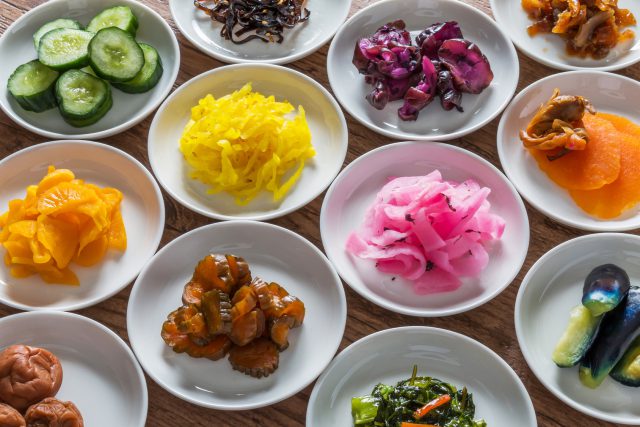
TSUKEMONO (pickled vegetables)
Effective for dieting
Approximately four times more dietary fiber intake when compared to just eating raw vegetables
Effect on health and beauty:
・Relaxation: Tsukemono has lots of calcium. Prevents nervousness and frustration by having an effect on the neurotransmitter function.
・Vitamin supplements: Nukazuke (fermented bed of rice bran) is especially rich with vitamins and minerals. Furthermore, the lactic acid reaches the intestines to create vitamins.
・Osteoporosis: The calcium in tsukemono is effective in the prevention of osteoporosis.
Overview:
・Japan has an extremely wide variety of pickles that counts over 600 types.
・There are different types of fermenting liquids and mush from soy, miso, rice bran, chilli, vinegar and sake (rice wine), among others.
・Depending on the season, different types of tsukemono can be made: sokuseki-zuke (instant pickles), ichiya-zuke (overnight pickles), asa-zuke (young pickles), furu-zuke (old pickles), among others. There is also takuan, which is made from dried Japanese radish pickled in nukamiso (fermented rice bran), as well as narazuke, which is salted cucumber that gets pickled once more with sake lees.
Characteristics:
・Vitamins break down in vegetables when heat is applied. Raw vegetables are difficult to consume in large quantities. But if you pickle them, the vitamin and dietary fiber remain the same, but the fermentation bacteria build up a variety of different vitamins in the vegetables, so that it becomes possible to efficiently absorb nutrients.
・Especially pickling with nukamiso infuses the vegetables with nutrients that are in the rice bran through the fermentation process, making it more nutritious and richer in taste.
Major area of production:
Japan
Nutrients:
Sodium, potassium, phosphorus, vitamin A and B6.

